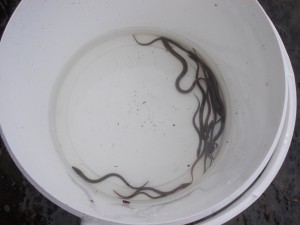The ZSL’s ‘Citizen Science’ European Eel monitoring Report 2012
Executive Summary
Over the past 30 years it has become apparent that European Eel (Anguilla anguilla) recruitment into European rivers has declined rapidly and despite the increased awareness of the situation, and the development of action plans and legislation at local, national and European levels, numbers do not appear to be recovering on a large scale.
In 2008 the International Union for Conservation of Nature classified the species as Critically Endangered. In 2005 ZSL set up its European eel monitoring programme to assess the presence of migrating juvenile eels, identify restrictions to their movements and gather long term data on trends in eel recruitment in the Thames catchment. In 2011, in order to expand this monitoring programme, ZSL began to engage the general public and enlist the help of volunteers.
ZSL now works with 10 partnership organisations and, to date, has trained 167 volunteers to become Citizen Scientists involved in the eel monitoring project. During the upstream juvenile eel migration period, April-October, Citizen Scientists check eel traps twice a week at eight monitoring sites in the Thames catchment. The number and size of all trapped eels are recorded and data are uploaded on to the ZSL database.
At the end of the monitoring season these data are feed into the Environment Agency’s Eel Management Plan for the Thames River Basin District. The programme fulfils an important research and educational role in the drive to improve rivers for eels. In the future, ZSL will work with its Citizen Science partners to emphasise the part they can play in helping this iconic species.
A particular problem in the River Thames catchment is the number of barriers, such as weirs, that prevent or hinder upstream migration and reduce the amount of available habitat to eels. We are working with our partners to identify the most significant barriers and build eel passes over a number of them to facilitate eel migration. Together, we can build capacity in the sector as a whole to tackle issues threatening the conservation of the European eel.
The Citizen Science European eel monitoring project will continue for the 2013 upstream juvenile eel migration period, however, In order to maintain conservation effort and build upon the valuable foundation that has been developed, ZSL will need to raise funds for the programme from spring 2014.
Full report can be found Here
This entry was posted in
News and tagged
Eels,
TAC,
Thames,
ZSL. Bookmark the
permalink.
 The Zoological Society of London’s Citizen Science, European Eel monitoring project Report for 2012
The Zoological Society of London’s Citizen Science, European Eel monitoring project Report for 2012
